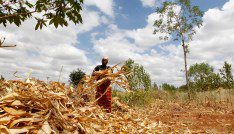More than 4 million people have died from COVID-19, and many others face long-lasting effects on their lives and livelihoods. While the full social, economic, and financial implications of COVID-19 are yet to be seen, millions have lost their jobs, and incomes in many countries have sharply declined. This raises concerns about sovereign debt sustainability and financial vulnerability in the medium term, particularly in developing countries and emerging markets.
Irene Monasterolo
Professor of Climate Finance, EDHEC Business School – EDHEC-Risk Institute, Nice, France
Senior Research Fellow – Vienna University of Economics and Business
Senior Research Fellow – Boston University
Nepomuk Dunz
Junior Professional Officer – World Bank
Andrea Mazzocchetti
Postdoctoral Researcher – Ca’ Foscari University of Venice, Italy
Arthur H. Essenfelder
Lead Researcher on Performance Assessment of Disaster Risk Reduction Strategies – Euro-Mediterranean Centre on Climate Change and Ca’ Foscari University of Venice, Italy
The pandemic diverted the attention from another ongoing crisis: Climate change has affected the lives of more than 130 million people and resulted in over 15,000 deaths since the beginning of the COVID-19 crisis. Natural hazards such as tropical cyclones, floods, and wildfires are expected to become more frequent and intense in the coming years.
Understanding the economic and financial impacts of compound risks
With worsening climate change, compound risks (e.g., floods and droughts or pandemics and hurricanes hitting the same country shortly thereafter) could be more likely in the future. This should be the main concern for governments and financial supervisors because compound risks could exacerbate social and financial vulnerabilities. For instance, natural hazards destroying socioeconomic infrastructures, such as hospitals, provide a fertile ground for pandemics to spread, thus strengthening the pandemic’s socioeconomic toll and delaying recovery. In countries with limited fiscal space and capacity to respond, compound risk can lead to substantial fiscal impacts and slowed recovery.
Related
The assessment and management of compound risks require a better understanding of how shocks of different nature (e.g., pandemics, climate change) are entering and passing through the economy. Eventually, we need to identify which assets and sectors are most vulnerable yet relevant in shocks’ transmission and amplification, in the economy and finance. This information would support policymakers and financial supervisors, answering the following questions “What are direct and indirect impacts of compound COVID-19 and climate physical risks, and how do they affect socio-economic and financial stability?” “Under which conditions can effective recovery policies be implemented?” “To what extent can countries strengthen their financial resilience to compound risks?”
Fit for purpose tools to assess compound risk
Answering these questions calls for macroeconomic models where heterogeneous agents—such as banks, firms, households, government, and a central bank—interact and adapt their investment and financing behavior, based on available information and on their expectations about the future. Consistently with the real world we live in, agents differ with regard to access to information (for instance, asset managers may have better information about financial market reaction to COVID-19 than car dealers) and risk management tools. Agents endowed with different access to information, preferences, and expectations, may diverge in their risk assessment and management strategies, with implications for the shock recovery.
Compound risk can amplify losses
A recent paper applies such a macroeconomic model to Mexico and shows that when shocks compound, such as the case of COVID-19 and natural disasters, losses could get amplified. Economic impacts are shock dependent, as a hurricane that might affect the supply side first by destroying productive plants and infrastructure differs from COVID-19 that enters as an aggregate demand shock by curbing people’s ability and willingness to spend money. The interplay between supply and demand shocks in the case of compound risk matters for the shock transmission through the economy and thus overall economic, private, and public finance impacts. This amplified impact is captured by the compound risk indicator in Figure 1, which compares GDP impacts of compound risks versus the sum of individually occurring pandemic and climate risk. A value of the indicator higher than 100 signals that the impact of the compound shocks is higher than the impact of the sum of individual shocks. In the case of a compounding strong climate physical shocks with COVID-19, non-linear amplification effects emerge.
Figure 1. Compound risk indicator for Mexico

Source: Dunz et al. 2021.
Drivers of shocks mitigation and amplification
Diverging preferences, expectations, and risk assessment are a main driver of compound shock amplification. Timely governments’ fiscal response is crucial to support the economic recovery and influence economic expectations. However, procyclical banks’ lending can counteract the effectiveness of fiscal stimulus by limiting firms’ recovery investments, creating the conditions for public finance distress (e.g., public debt sustainability). For instance, banks may revise their lending conditions to firms due to the uncertainty about the duration of the crisis, despite government and central banks’ actions (e.g., credit guarantees, recovery investments). By limiting the ability of firms to invest and of households to consume, procyclical lending can trigger persistent and nonlinear macroeconomic effects, such as higher unemployment and lower GDP (Figure 1).
Banks’ lending behavior is thus relevant for the success of government fiscal policies, and for their financial sustainability. Indeed, government’s recovery funds, financed by issuance of debt, are less effective in fostering the economic recovery in presence of credit and labor constraints. Coordination of fiscal and financial policies could help to tackle the complexity of the implications of compound risk, creating the conditions for functioning credit markets, and preserving sovereign debt sustainability.
Insights to build back better
Introducing compound risk considerations in fiscal and financial risk management can help governments and financial authorities build resilience to compounding shocks that could be more likely in the near future. Nevertheless, the assessment of compound risks requires an adaptation of the analytical tools that support policy making. Accounting for adaptive expectations and finance-economy interactions (e.g., bank lending conditions) that affect economic and financial agents’ response (e.g., investment, consumption) in times of crises could improve our understanding of how and why individual and compounding shock impacts might amplify. Such a new generation of macroeconomic models can thus support investors and policy makers in the assessment of risk and in the design of better-informed risk financing strategies. This, in turn, would enable the role of public and private finance in building resilience to compounding climate, pandemic, and other risks, for the benefit of the environment, the economy, and society.





